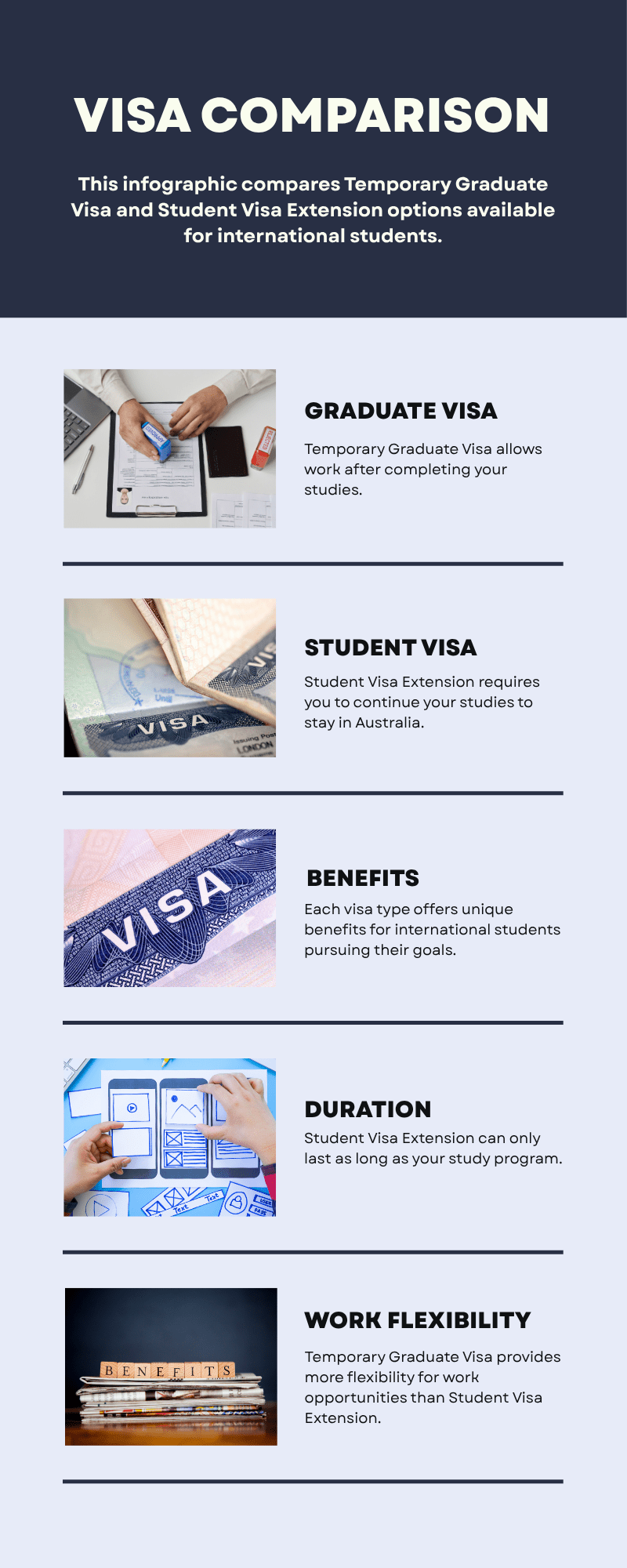Two popular pathways post-graduation or mid-study are the Temporary Graduate Visa vs Student Visa. The former offers a bridge to professional life, allowing unrestricted work rights after studies, while the latter keeps you in the academic fold by extending your study period.
Navigating Australia’s immigration landscape as an international student can be both exciting and daunting. After investing time, money, and effort into pursuing higher education Down Under, the next big question often revolves around staying longer to gain work experience, complete further studies, or transition toward permanent residency.
As of September 29, 2025, Australia’s visa policies continue to evolve, influenced by migration caps, economic needs, and international relations. Recent updates include stricter English language requirements for the Subclass 485 visa, fee hikes across both visa types, and the mandatory Confirmation of Enrolment (CoE) requirement for onshore Student Visa applications.
This article delves deeply into both options, explaining their types, subtypes, eligibility criteria, processes, and associated costs. We’ll compare them side by side with tables for clarity and highlight the latest 2025 changes. Whether you’re eyeing full-time employment or another degree, understanding these visas is crucial for seamless planning.
For those tackling English proficiency tests like the PTE (Pearson Test of English), which is pivotal for both visas, resources such as freeptetest.com provide invaluable free practice tests to boost your scores efficiently.
Understanding the Temporary Graduate Visa (Subclass 485)
The Temporary Graduate Visa (Subclass 485) is a post-study work visa designed for international students who have completed their Australian qualifications. It replaced older programs, such as the Subclass 457, and aims to retain skilled talent by granting temporary residency with full work rights.
Unlike study visas, it doesn’t tie you to a specific course—you can work in any occupation, pursue further studies, or travel freely. The visa is valid for 18 months to five years, depending on your stream, qualification, and study location (regional areas often receive additional benefits).
As of 2025, the Subclass 485 operates through two primary streams: the Post-Higher Education Work Stream and the Post-Vocational Education Work Stream. The Replacement Stream, which allowed transitions from defunct visas, closed to new applications on July 1, 2024, leaving no revival in sight.
Applications must be lodged within six months of course completion, and you can’t apply if you’ve held a Subclass 485 before (except in specific second-stream cases).
Post-Higher Education Work Stream
This is the flagship stream for graduates of bachelor’s, master’s, or doctoral programs from Australian institutions. It’s tailored for those pursuing higher-level skills in fields like engineering, IT, healthcare, and business, aligning with Australia’s skilled migration priorities.
Eligibility Criteria:
- Age: Under 50 years at application time (exceptions for PhD holders up to 55).
- Qualification: A degree (AQF Level 7 or higher) completed in Australia within the last 48 months. From December 14, 2024, only CRICOS-registered courses count, excluding some online or short programs.
- Study Requirement: At least two academic years (92 weeks) of full-time study in Australia.
- English Proficiency: Competent English, now with updated 2025 rules effective August 7: IELTS 6.0 overall (no band below 5.0), PTE 50 overall (no communicative skill below 36), or equivalent. New tests like OET and Cambridge C1 Advanced have adjusted minimums, emphasizing vocational relevance. Prepare via platforms like freeptetest.com for PTE mocks.
- Health and Character: Standard checks, including police clearances.
- Location Bonus: Studying in regional areas (e.g., outside Sydney, Melbourne, Brisbane) adds 1-2 years.
Duration:
- Bachelor’s: 2 years.
- Master’s (coursework): 2 years.
- Master’s (research) or PhD: 3 years.
- Regional study: Up to 5 years for PhDs in designated areas.
Application Process:
- Gather documents: Degree certificate, transcripts, skills assessment (if needed), English test results.
- Create an ImmiAccount on the Department of Home Affairs website.
- Lodge online with Form 485; processing time is 4-6 months in 2025.
- Biometrics may be required at a VFS center.
Costs: Base fee AUD $1,895 (increased as of February 1, 2025); additional fees apply for family members (AUD $450-$ 1,895). Health surcharge applies (~AUD $500).
This stream underwent tweaks in July 2025, tightening eligibility for non-STEM fields to prioritize areas of shortage.
Post-Vocational Education Work Stream
Aimed at trade and vocational graduates, this stream suits those with diplomas or advanced diplomas (AQF Level 5-6) in occupations such as carpentry, nursing, or hospitality management. It’s shorter but accessible for non-university paths.
Eligibility Criteria:
- Age: Under 35 (stricter than higher stream).
- Qualification: Diploma or trade qualification completed in Australia within 24 months; must be on the Medium and Long-term Strategic Skills List (MLTSSL).
- Study Requirement: 92 weeks of CRICOS-registered vocational study.
- English Proficiency: Same as above, with 2025 updates applying—PTE 50 minimum recommended via freeptetest.com practice.
- Skills Assessment: Mandatory from a relevant authority (e.g., VETASSESS).
- Health and Character: As standard.
Duration: 18 months standard; no regional extensions.
Application Process: Identical to the higher stream, but include skills assessment. Processing: 3-5 months.
Costs: Same base fee AUD $1,895, plus assessment (~AUD $1,000).
Updates in 2025 include expanded eligible trades due to labor shortages, but age caps remain firm.

Second Post-Higher Education Work Stream
Introduced in late 2024 as a “second chance” for prior Subclass 485 holders, this subtype allows one additional stint for those who’ve exhausted their first Post-Higher Education visa. It’s not a full new application but an extension-like bridge.
Eligibility Criteria:
- Previously held a Post-Higher Education 485 visa.
- Under 35-50 (depending on original qualification).
- No further study required, but English must be re-proven if expired.
- 2025 updates: Limited to regional commitments for longer durations.
Duration: 1-2 years, based on regional study history.
Application Process: Streamlined online, with faster processing (2-4 months).
Costs: Reduced base fee AUD $1,200.
This stream addresses retention, with 2025 caps on applications to manage numbers.
Exploring Student Visa Extensions (Subclass 500)
The Student Visa (Subclass 500) is the primary visa for international students enrolled in CRICOS-registered courses. Unlike the Subclass 485, it mandates full-time study and limits work to 48 hours per fortnight during term (unlimited in breaks).
“Extension” isn’t a formal term— you must apply for a new Subclass 500 visa before your current one expires to continue studying. This could mean packaging multiple courses (e.g., diploma to bachelor’s) or standalone extensions for research/master’s extensions. Bridging Visa A (BVA) grants interim stay while processing.
As of 2025, extensions are onshore-friendly but scrutinized under the Genuine Student (GS) test, ensuring you’re not using study as a migration ploy. No subtypes per se, but options vary by study level.
Options for Extending the Student Visa
- Course Packaging Extension: Enroll in a related higher-level course (e.g., from certificate to degree). This “packages” visas into one grant, covering the full duration.
Eligibility: Genuine intent to study; GTE statement; financial proof (AUD $29,710/year living costs + tuition).
Duration: Course length + 1-5 months extra (e.g., 2 months for <1-year course; 5 for PhD).
- Standalone Reapplication: Apply for a new visa for a new or extended course without packaging.
Eligibility: Same as above; must hold valid CoE from January 1, 2025—no more Letters of Offer for onshore apps.
- Research or Thesis Extension: For master’s/PhD students needing extra time.
Eligibility: University endorsement; proof of progress.
English Proficiency: Functional English: IELTS 5.5 or PTE 42. Updates align with 485 changes, but lower thresholds. Freeptetest.com is ideal for brushing up.
Application Process:
- Obtain new CoE from your institution.
- Lodge via ImmiAccount before expiry (up to 6 months prior).
- Pay fees; attend biometrics if needed.
- Processing: 1-3 months; BVA activates automatically onshore.
Costs: AUD $2,000 base from July 1, 2025 (up from $1,600); exemptions for Pacific Islanders from March 22. Family add-ons: AUD $1,600.
Key 2025 rule: Onshore applicants must submit CoE upfront, reducing “visa hopping.” Time abroad doesn’t extend validity.
Latest Updates as of September 2025 for Temporary Graduate Visa vs Student Visa
Australia’s 2025 migration agenda tightens student inflows while boosting graduate retention. For Subclass 485:
- English Overhaul (August 7): Raised PTE thresholds to 50; OET now accepted with B in all sections. Impacts ~20% of applicants—practice on freeptetest.com to comply.
- Fee Surge (February 1): +10% across streams, hitting AUD $1,895 base.
- Qualification Tweaks (December 2024 onward): Phased out non-CRICOS quals; regional incentives enhanced for 5-year PhD stays.
- July 1 Changes: Age cap to 35 for vocational stream; second stream caps at 10,000 annually.
For Student Visa extensions:
- CoE Mandate (January 1): Ends offer-letter reliance, streamlining but catching “non-genuine” apps.
- Fee Hike (July 1): To AUD $2,000, with processing times up to 90 days amid backlogs.
- Work Limits: Unchanged at 48 hours/fortnight, but unlimited holidays confirmed.
- Pacific Perks (March 22): Reduced fees to AUD $1,000 for eligible nations.
These shifts reflect a post-2024 cap on international students, prioritizing quality over quantity.
Comparison: Temporary Graduate Visa (485) vs. Student Visa Extension (500)
To aid decision-making, here’s a side-by-side breakdown:
Aspect | Temporary Graduate Visa (485) | Student Visa Extension (500) |
Primary Purpose | Post-study work and skill-building | Continued full-time study |
Streams/Subtypes | Post-Higher (2-5 yrs), Post-Vocational (18 mos), Second Post-Higher (1-2 yrs) | Course Packaging, Standalone, Research Extension |
Work Rights | Unlimited in any job | 48 hrs/fortnight (unlimited breaks) |
Duration | 18 months to 5 years | Course length + 1-5 months |
Eligibility Age | Under 35-50 (stream-dependent) | No age limit, but GTE scrutiny for older applicants |
English Req. | Competent (PTE 50, updated 2025) | Functional (PTE 42) |
Application Timing | Within 6 months of graduation | Before current visa expiry |
Costs (2025) | AUD $1,895 base + health surcharge | AUD $2,000 base + tuition |
Path to PR | Strong (leads to 189/190/491) | Indirect (via 485 after studies) |
Family Inclusion | Yes, with work rights | Yes, but limited work (24 hrs/fortnight) |
2025 Updates | Stricter English/qualifications; fee up | CoE mandatory; fee up; faster processing for packages |
This table highlights the 485’s flexibility for career starters versus the 500’s academic focus. Choose 485 for work immersion; extend 500 if more study beckons.
In 2025, the Temporary Graduate Visa (Subclass 485) shines as a golden ticket for post-study independence, with its streams offering tailored durations and work freedoms, albeit with tightened English and qualification bars.
Conversely, Student Visa extensions via Subclass 500 provide continuity for academic pursuits but demand rigorous re-proof of intent and come with study/work restrictions. Both pathways, updated amid Australia’s balanced migration strategy, pave routes to longer stays—potentially permanent residency.
Consult a registered migration agent for personalized advice, and leverage tools like freeptetest.com for English prep. With proactive planning, your Australian chapter can extend far beyond graduation.



